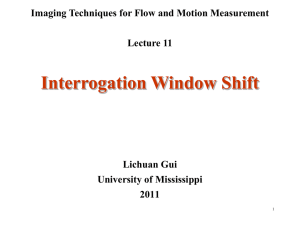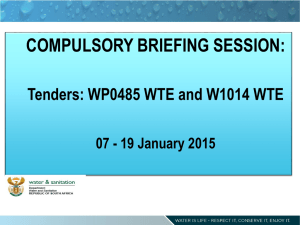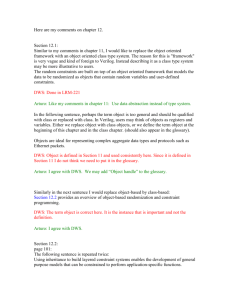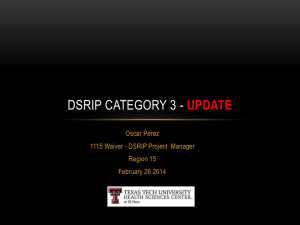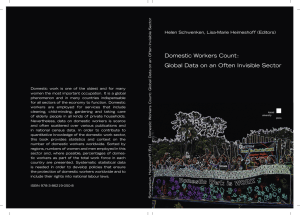Diffusing Wave Spectroscopy and micro
advertisement
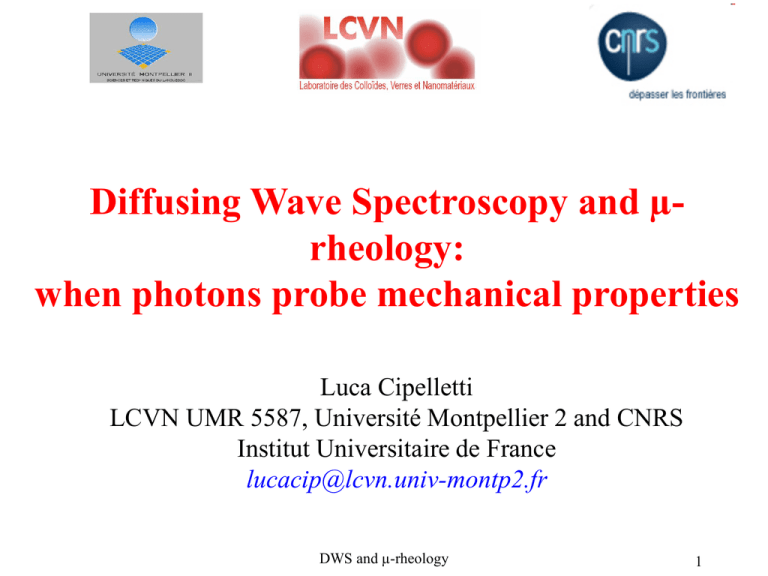
Diffusing Wave Spectroscopy and µrheology: when photons probe mechanical properties Luca Cipelletti LCVN UMR 5587, Université Montpellier 2 and CNRS Institut Universitaire de France lucacip@lcvn.univ-montp2.fr DWS and µ-rheology 1 Outline • Mechanical rheology and µ-rheology • µ-rheology : a few examples • Mesuring displacements at a microscopic level: DWS • The multispeckle « trick » • Conclusions DWS and µ-rheology 2 Rheology and ... Mechanical rheology: measure relation between stress and deformation (strain) In-phase response elastic modulus G’(w) Out-of-phase response loss modulus G"(w) DWS and µ-rheology 3 ... µ-rheology Active µ - Rheology : seed the sample with micron-sized beads, impose microscopic displacements with optical tweezers, magnetic fields etc., measure the stress-strain relation. Passive µ - Rheology : let thermal energy do the job, measure deformation (« weak » materials, small quantities, high frequencies…) DWS and µ-rheology 4 Passive µ-rheology Water Concentrated solution of DNA (simple fluid) (viscoelastic fluid) Source: D. Weitz's webpage Bead size: 2 mm Key step : measure displacement on microscopic length scales DWS and µ-rheology 5 Outline • Mechanical rheology and µ-rheology • µ-rheology : a few examples • Mesuring displacements at a microscopic level: DWS • The multispeckle « trick » • Conclusions DWS and µ-rheology 6 A simple example: a Newtonian fluid Water: G'(w) = 0, G"(w) = hw D. Weitz's webpage 0.5 mm T. Savin's webpage Mean Square Displacement k BT 2 r ( ) 6D D 6ha k BT h r 2 ( ) a DWS and µ-rheology 7 Generalization to a viscoelastic fluid Intuitive approach for a Newtonian fluid: h a k BT taking w = 1/ 2 r ( ) G" (w ) wh k BT a r 2 (1 / w ) Rigorous, general approach: or Fourier transform Laplace transform G*(w) = G'(w) + iG"(w) DWS and µ-rheology 8 A Maxwellian fluid (from A. Cardinaux et al., Europhys. Lett. 57, 738 (2002)) Plateau modulus: G0 Relaxation time : r Viscosity: h = G0r Rough idea: solid on a time scale << r, with modulus G0 Liquid on a time scale >> r, with viscosity h = G0r solvent viscosity get G0 G0/2 r 1/r solvent viscosity DWS and µ-rheology 9 Passive µ-rheology: the key step Seed the sample with probe particles, then : Obtain G’(w), G"(w) Measure mean squared displacement <r2(t)> 0.1 µm <r2> has to be measured on length scales < 1 nm to 1µm ! 1 nm DWS and µ-rheology 10 Outline • Mechanical rheology and µ-rheology • µ-rheology : a few examples • Mesuring displacements at a microscopic level: DWS • The multispeckle « trick » • Conclusions DWS and µ-rheology 11 Light scattering: the concept A light scattering experiment Speckle image q DWS and µ-rheology 12 From particle motion to speckle fluctuations r(t) r(t+) DWS and µ-rheology 13 From particle motion to speckle fluctuations Weakly scattering media (single scattering) Speckles fluctuate if r() ~ l ~0.5 µm (Dynamic Light Scattering) r(t) r(t+) DWS and µ-rheology 14 Diffusing Wave Spectroscopy (DWS): DLS for turbid samples Detector DWS and µ-rheology Photon propagation: Random walk 15 Diffusing Wave Spectroscopy (DWS): DLS for turbid samples L l* Detector Photon propagation: Random walk Speckles fully fluctuate for r2> ~ l2 / Nsteps = l2 / (L/ l* )2 << l2 Typically: L ~ 0.1-1 cm, l* ~ 10-100 µm r2> as small as a few Å2! DWS and µ-rheology 16 How to quantify intensity fluctuations Photomultiplier (PMT)signal I PMT c t Intensity autocorrelation function g 2 ( ) 1 I (t ) I (t ) I (t ) 2 g2-1 t 1 t c (other functions may be used, see L. Brunel's talk) DWS and µ-rheology 17 From g2()-1 to <r2()> • Well established formalism exists since ~1988 • Depends on the geometry of the experiment A good choice: the backscattering geometry g 2 ( ) 1 exp 2 2n k02 l r 2 ( ) k02 2 2 Note: no dependence on l* (corrections are necessary for finite sample thickness, curvature, see L. Brunel's talk) DWS and µ-rheology 18 Outline • Mechanical rheology and µ-rheology • µ-rheology : a few examples • Mesuring displacements at a microscopic level: DWS • The multispeckle « trick » • Conclusions DWS and µ-rheology 19 The problem: time averages! g 2 ( ) 1 I (t ) I (t ) I (t ) 2 t 1 t max= 20 s Texp ~ 1 day! I(t) PMT signal • Average over ~ Texp = 103-104 max Could be too long! • Time-varying samples? (aging, aggregation...) • Sample should explore all possible configurations over time (ergodicity). Gels? Pastes? DWS and µ-rheology 20 The Multispeckle technique Average g2()-1 measured in parallel for many speckles I1(t)I1(t+) I2(t)I2(t+) I3(t)I3(t+) I4(t)I4(t+) … CCD or CMOS camera g 2 ( ) 1 I p (t ) I p (t ) I p (t ) DWS and µ-rheology 2 p ,t 1 p ,t 21 The Multispeckle technique (MS) g 2 ( ) 1 I p (t ) I p (t ) I p (t ) 2 p ,t 1 max= 20 s Texp ~ 20 s! p ,t • slow relaxations, • non-stationary dynamics • non-ergodic samples (gels, pastes, foams, concentrated emulsions...) Smart algorithms needed to cope with the large amount of data to be processed, see L. Brunel's talk DWS and µ-rheology 22 Outline • Mechanical rheology and µ-rheology • µ-rheology : a few examples • Mesuring displacements at a microscopic level: DWS • The multispeckle « trick » • Conclusions DWS and µ-rheology 23 µ-rheology First paper: Mason & Weitz, 1995 (306 citations) Since then: > 680 papers DWS First papers: 1988 Since then: > 1470 papers Number of µ-Rheology papers µ-rheology and DWS: a well established field, but in its commercial infancy! 120 100 80 60 40 20 0 1996 1997 1998 1999 2000 2001 2002 2003 2004 2005 2006 2007 2008 Publication year DWS and µ-rheology 24 MSDWS µ-rheology g2()-1 Multispeckle DWS • Reduced Texp • Time-varying dynamics • Non-ergodic samples r2() G'(w), G"(w) µ-rheology • Linear response probed • No inhomogeneous response • Full spectrum at once • No need to load/unload rheometer • Cheaper • Sensitive to nanoscale motion • Good average over probes • Optically simple & robust • No stringent requirements on optical properties (turbidity...) DWS and µ-rheology 25 Useful references Useful references: [1] D. Weitz and D. Pine, Diffusing Wave Spectroscopy in Dynamic Light Scattering, Edited by W. Brown, Clarendon Press, Oxford, 1993 [2] M.L. Gardel, M.T. Valentine, D. A. Weitz, Microrheology, Microscale Diagnostic Techniques K. Breuer (Ed.) Springer Verlag (2005) or at http://www.deas.harvard.edu/projects/weitzlab/papers/urheo_chapter.pdf DWS and µ-rheology 26 Additional material DWS and µ-rheology 27 µ-rheology: from <r2> to G’, G" or General formulas: Simpler approach (T. Mason, see [2]) assume that locally <r2> be a power law: then, with and DWS and µ-rheology 28 DWS: qualitative aproach l = 1/rs scattering mean free path l* transport mean free path l* = l /<1-cosq> l l* Number of scattering events along a path across a cell of thickness L: N ~ (L/ l * )2 (l * / l ) [L/ l * 10-100, typically] Change in photon phase due to a particle displacement r (over a single random walk step): df ~ <q2><r2> ~ k02<r2> Total change in photon phase for a path (uncorrelated particle motion): f ~ k02<r2> (L/ l * )2 Complete decorrelation of DWS signal for f ~ 2: r2> ~ l2 / (L/ l * )2 << l2 [r2> as small as a few Å2!!] Weitz & Pine DWS and µ-rheology 29 DWS: quantitative approach Intensity correlation function g2(t)-1 = b [g1(t)]2 (incoherent) sum over photon paths with t/ = k02< r2(t)>/ 6, k0 = 2/l, and P(s) path length distribution (example: for brownian particles, <r2(t)> = 6Dt and t/ = t k02D Note: P(s) (and hence g1) depend on the experimental geometry! for analytical expression of g1 in various geometries (transmission, backscattering) see Weitz & Pine [1] DWS and µ-rheology 30 Backscattering geometry g1(t) ~ ~ exp 6t / independent of l*: don’t need to know/measure l*! = (k02D)-1 DWS and µ-rheology 31 Transmission geometry = (k02D)-1 g1(t) Note: l* has to be determined. Measure transmission T 5l * / 3L 5l * / 3L 1 4l * / 3L Calibrate against reference sample DWS and µ-rheology 32
